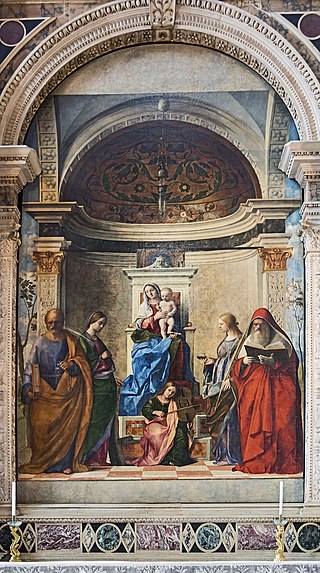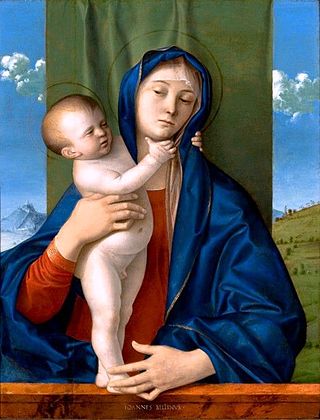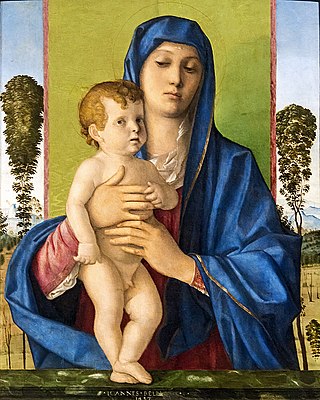
Giovanni Bellini was an Italian Renaissance painter, probably the best known of the Bellini family of Venetian painters. He was raised in the household of Jacopo Bellini, formerly thought to have been his father, but now that familial generational relationship is questioned. An older brother, Gentile Bellini was more highly regarded than Giovanni during his lifetime, but the reverse is true today. His brother-in-law was Andrea Mantegna.

BartolomeoMontagna was an Italian Renaissance painter who mainly worked in Vicenza. He also produced works in Venice, Verona, and Padua. He is most famous for his many Madonnas and his works are known for their soft figures and depiction of eccentric marble architecture. He is considered to be heavily influenced by Giovanni Bellini, in whose workshop he might have worked around 1470. Benedetto Montagna, a productive engraver, was his son and pupil and active until about 1540. He was mentioned in Vasari's Lives as a student of Andrea Mantegna but this is widely contested by art historians.

Giovanni Battista Cima, also called Cima da Conegliano, was an Italian Renaissance painter, who mostly worked in Venice. He can be considered part of the Venetian school, though he was also influenced by Antonello da Messina, in the emphasis he gives to landscape backgrounds and the tranquil atmosphere of his works. Once formed his style did not change greatly. He mostly painted religious subjects, often on a small scale for homes rather than churches, but also a few, mostly small, mythological ones.

The Pinacoteca di Brera is the main public gallery for paintings in Milan, Italy. It contains one of the foremost collections of Italian paintings from the 13th to the 20th century, an outgrowth of the cultural program of the Brera Academy, which shares the site in the Palazzo Brera.

The Madonna and Child Between St. Francis and St. Nicasius, also known as Castelfranco Madonna or Pala di Castelfranco, is a painting by the Italian Renaissance artist Giorgione executed around 1504. It remains in the equivalent of its original setting, in a side-chapel of the Cathedral of Castelfranco Veneto, Giorgione's native city, in Veneto, northern Italy, although the present church dates to the 18th century.

This article about the development of themes in Italian Renaissance painting is an extension to the article Italian Renaissance painting, for which it provides additional pictures with commentary. The works encompassed are from Giotto in the early 14th century to Michelangelo's Last Judgement of the 1530s.

Crucifixion is a painting by the Italian Renaissance painter Giovanni Bellini, created around 1455–1460. It is housed in the Museo Correr in Venice.

Madonna del Prato is a 1505 painting of the Virgin Mary and the Christ Child by Giovanni Bellini, now in the National Gallery in London. Originally painted as oil and egg tempera on wood, it was transferred to canvas in 1949, with damage in places.

The San Zaccaria Altarpiece is a painting by the Italian Renaissance painter Giovanni Bellini, executed in 1505 and located in the church of San Zaccaria, Venice.

The Madonna and Child Enthroned with Saints John the Baptist and Sebastian is a painting by the Italian Renaissance artist Pietro Perugino, executed in 1493 and housed in the Uffizi Gallery, Florence.

The San Giobbe Altarpiece is a c. 1487 oil painting by the Italian Renaissance master Giovanni Bellini. Inspired by a plague outbreak in 1485, this sacra conversazione painting is unique in that it was designed in situ with the surrounding architecture of the church, and was one of the largest sacra conversazione paintings at the time. Although it was originally located in the Church of San Giobbe, Venice, it is now housed in the Gallerie dell'Accademia in Venice after having been stolen by Napoleon Bonaparte.

The Gypsy Madonna is a panel painting of the Madonna and Child in oils of about 1510–11, by Titian, now in the Kunsthistorisches Museum in Vienna. It is a painting made for display in a home rather than a church.

Virgin with the Standing Child, Embracing his Mother, also known as Willys Madonna is a painting by the Italian Renaissance master Giovanni Bellini. It is now in the São Paulo Museum of Art in São Paulo, Brazil.

The Madonna with Child, or Alzano Madonna, is an oil on panel painting by Italian Renaissance artist Giovanni Bellini, executed around 1485.

The Madonna of the Small Trees is an oil on panel painting by Italian Renaissance artist Giovanni Bellini, executed in 1487. It is housed in the Gallerie dell'Accademia in Venice.

Pietro degli Ingannati, also Pellegrino di Giovanni di Antonio, was an Italian Renaissance painter who is known for his paintings of the Virgin and Child and his portraits.

Madonna and Child with Saint Mary Magdalene and Saint Ursula or Virgin and Child with Saints Magdalene and Ursula is an oil on panel painting by Giovanni Bellini that belongs to the sacra conversazione genre and dates to 1490. The painting is also referred to as Sacred Conversation. It was previously in the collection of the painter Carlo Maratta, and is now in the Prado Museum in Madrid.

The Madonna and Child with St. John the Baptist and a Female Saint or the Giovanelli Sacred Conversation is an oil painting on panel by Giovanni Bellini, dated to before 1504. It is kept in the Gallerie dell'Accademia of Venice.


















